Application of Infrared Spectroscopy in Research on Aging of Silicone Rubber in Harsh Environment
Abstract
:1. Introduction
2. Materials and Methods
2.1. Samples
2.2. Aging Experiment and Test Method
3. Results and Discussion
3.1. Outdoor High Altitude Environment
3.1.1. Infrared Absorption Peak
3.1.2. Ratio H of Characteristic Group Absorption Peak Height
3.2. Salt-Fog Environment
3.2.1. Infrared Absorption Peak
3.2.2. Ratio H of Characteristic Group Absorption Peak Height
3.3. Corrosive Acid-Fog Environment
3.3.1. Infrared Absorption Peak
3.3.2. Ratio H of Characteristic Group Absorption Peak Height
4. Conclusions
Author Contributions
Funding
Institutional Review Board Statement
Data Availability Statement
Conflicts of Interest
References
- Madi, A.; He, Y.; Jiang, L. Design and testing of an improved profile for silicone rubber composite insulators. IEEE Trans. Dielectr. Electr. Insul. 2017, 24, 2930–2936. [Google Scholar] [CrossRef]
- Xidong, L.; Shaowu, W.; Ju, F.; Zhicheng, G. Development of composite insulators in China. IEEE Trans. Dielectr. Electr. Insul. 1999, 6, 586–594. [Google Scholar] [CrossRef]
- Hackam, R. Outdoor HV composite polymeric insulators. IEEE Trans. Dielectr. Electr. Insul. 1999, 6, 557–585. [Google Scholar] [CrossRef]
- Reynders, J.P.; Jandrell, I.R. Review of aging and recovery of silicone rubber insulation for outdoor use. IEEE Trans. Dielectr. Electr. Insul. 1999, 6, 620–631. [Google Scholar] [CrossRef]
- Rajini, V.; Udayakumar, K. Degradation of silicone rubber under AC or DC voltages in radiation environment. IEEE Trans. Dielectr. Electr. Insul. 2009, 16, 834–841. [Google Scholar] [CrossRef]
- Ahmadi-Joneidi, I.; Majzoobi, A.; Shayegani-Akmal, A.A.; Mohseni, H.; Jadidian, J. Aging evaluation of silicone rubber insulators using leakage current and flashover voltage analysis. IEEE Trans. Dielectr. Electr. Insul. 2013, 20, 212–220. [Google Scholar] [CrossRef]
- Haddad, A.; Waters, R.T.; Griffiths, H.; Chrzan, K.; Harid, N.; Sarkar, P.; Charalampidis, P. A new approach to anti-fog design for polymeric insulators. IEEE Trans. Dielectr. Electr. Insul. 2010, 17, 343–350. [Google Scholar] [CrossRef] [Green Version]
- Fujii, O.; Honsali, K.; Mizuno, Y.; Naito, K. A basic study on the effect of voltage stress on a water droplet on a silicone rubber surface. IEEE Trans. Dielectr. Electr. Insul. 2009, 16, 116–122. [Google Scholar] [CrossRef]
- Gubanski, S.M. Modern outdoor insulation-concerns and challenges. IEEE Electr. Insul. Mag. 2005, 21, 5–11. [Google Scholar] [CrossRef]
- Sarathi, R.; Mishra, P.; Gautam, R.; Vinu, R. Understanding the influence of water droplet initiated discharges on damage caused to corona-aged silicone rubber. IEEE Trans. Dielectr. Electr. Insul. 2017, 24, 2421–2431. [Google Scholar] [CrossRef]
- Moghadam, M.K.; Taheri, M.; Gharazi, S.; Keramati, M.; Bahrami, M.; Riahi, N. A study of composite insulator aging using the tracking wheel test. IEEE Trans. Dielectr. Electr. Insul. 2016, 23, 1805–1811. [Google Scholar] [CrossRef]
- Jiang, X.; Guo, Y.; Meng, Z.; Li, Z.; Jiang, Z. Additional Salt Deposit Density of Polluted Insulators in Salt Fog. IET Gener. Transm. Distrib. 2016, 10, 3691–3697. [Google Scholar] [CrossRef]
- Fernando, M.A.R.M.; Gubanski, S.M. Ageing of Silicone Rubber Insulators in Coastal and Inland Tropical Environment. IEEE Trans. Dielectr. Electr. Insul. 2010, 17, 326–333. [Google Scholar] [CrossRef]
- Reddy, B.S.; Prasad, D.S. Corona Degradation of the Polymer Insulator Samples under Different Fog Conditions. IEEE Trans. Dielectr. Electr. Insul. 2016, 23, 359–367. [Google Scholar] [CrossRef]
- Reddy, B.S.; Prasad, D.S. Effect of coldfog on the corona induced degradation of silicone rubber samples. IEEE Trans. Dielectr. Electr. Insul. 2015, 22, 1711–1718. [Google Scholar] [CrossRef]
- Montesinos, J.; Gorur, R.S.; Goudie, J. Electrical performance of RTV silicone rubber coatings after exposure to an acidic environment. In Proceedings of the Conference on Electrical Insulation & Dielectric Phenomena, Atlanta, GA, USA, 25–28 October 1998. [Google Scholar]
- Zhang, Z.; Pang, G.; Ma, X.; Liang, T.; Jiang, X. Mechanical Properties of High-Temperature Vulcanized Silicone Rubber under Acid-Fog with AC Energized. IEEE Access 2022, 10, 95553–95564. [Google Scholar] [CrossRef]
- Ali, M.; Hackam, R. Recovery of hydrophobicity of HTV silicone rubber after accelerated aging in saline solutions. IEEE Trans. Dielectr. Electr. Insul. 2009, 16, 842–852. [Google Scholar] [CrossRef]
- Tu, Y.; Zhang, H.; Xu, Z.; Chen, J.; Chen, C. Influences of electric-field distribution along the string on the aging of composite insulators. IEEE Trans. Power Del. 2013, 28, 1865–1871. [Google Scholar]
- Gao, Y.; Wang, J.; Liang, X.; Yan, Z.; Liu, Y.; Cai, Y. Investigation on permeation properties of liquids into HTV silicone rubber materials. IEEE Trans. Dielectr. Electr. Insul. 2014, 21, 2428–2437. [Google Scholar] [CrossRef]
- Liu, H.; Cash, G.; Birtwhistle, D.; George, G. Characterization of a severely degraded silicone elastomer HV insulator—An aid to development of lifetime assessment techniques. IEEE Trans. Dielectr. Electr. Insul. 2005, 12, 478–486. [Google Scholar]
- Song, W.; Shen, W.W.; Zhang, G.J.; Song, B.P.; Lang, Y.; Su, G.Q.; Mu, H.B.; Deng, J.B. Aging characterization of high temperature vulcanized silicone rubber housing material used for outdoor insulation. IEEE Trans. Dielectr. Electr. Insul. 2015, 22, 961–969. [Google Scholar] [CrossRef]
- Chen, C.; Jia, Z.; Wang, X.; Lu, H.; Guan, Z.; Yang, C. Micro characterization and degradation mechanism of liquid silicone rubber used for external insulation. IEEE Trans. Dielectr. Electr. Insul. 2014, 22, 313–321. [Google Scholar] [CrossRef]
- Zhang, Z.; Liang, T.; Li, C.; Jiang, X.; Wu, J.; Wu, B. Electrical Strength and Physicochemical Performances of HTV Silicone Rubber under Salt-Fog Environment with DC Energized. Polymers 2020, 12, 324. [Google Scholar] [CrossRef] [PubMed]
- Zhang, Z.J.; Liang, T.; Jiang, X.L.; Li, C.; Yang, S.H.; Zhang, Y. Characterization of silicone rubber degradation under salt-fog environment with AC test voltage. IEEE Access 2019, 7, 66714–66724. [Google Scholar]
- Huang, H.; Liang, T.; Li, B.; Ma, X.; Mao, X.; Lü, Q. Effect of Acidic-fog on performances of HTV silicone rubber with AC energized. Eng. Fail. Anal. 2022, 132, 105880. [Google Scholar] [CrossRef]
- GB/T 26218.3; Selection and Size Determination of High Voltage Insulators Used under Contaminated Conditions Part 3: Composite Insulators for AC Systems. Standardization Administration of China: Beijing, China, 2011.
- GB/T 16434-1996; Environment Pollution Classification and External Insulation Selection for High Voltage Transmission Line, Power Plant and Substation. State Bureau of Quality and Technical Supervision: Beijing, China, 1996.
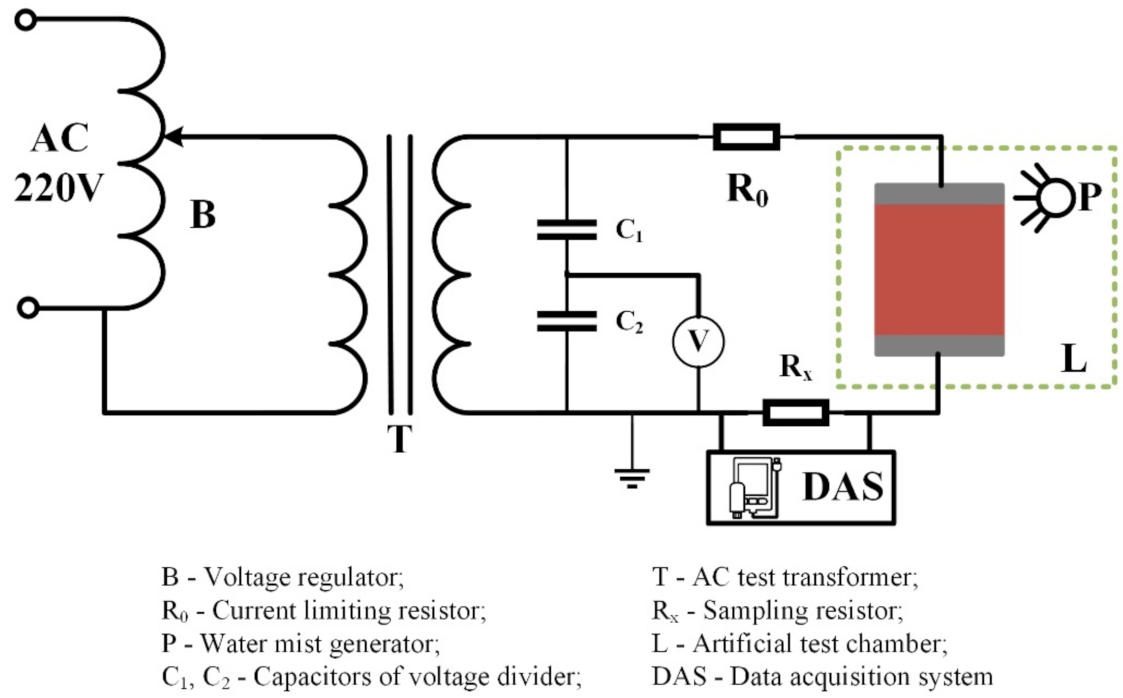




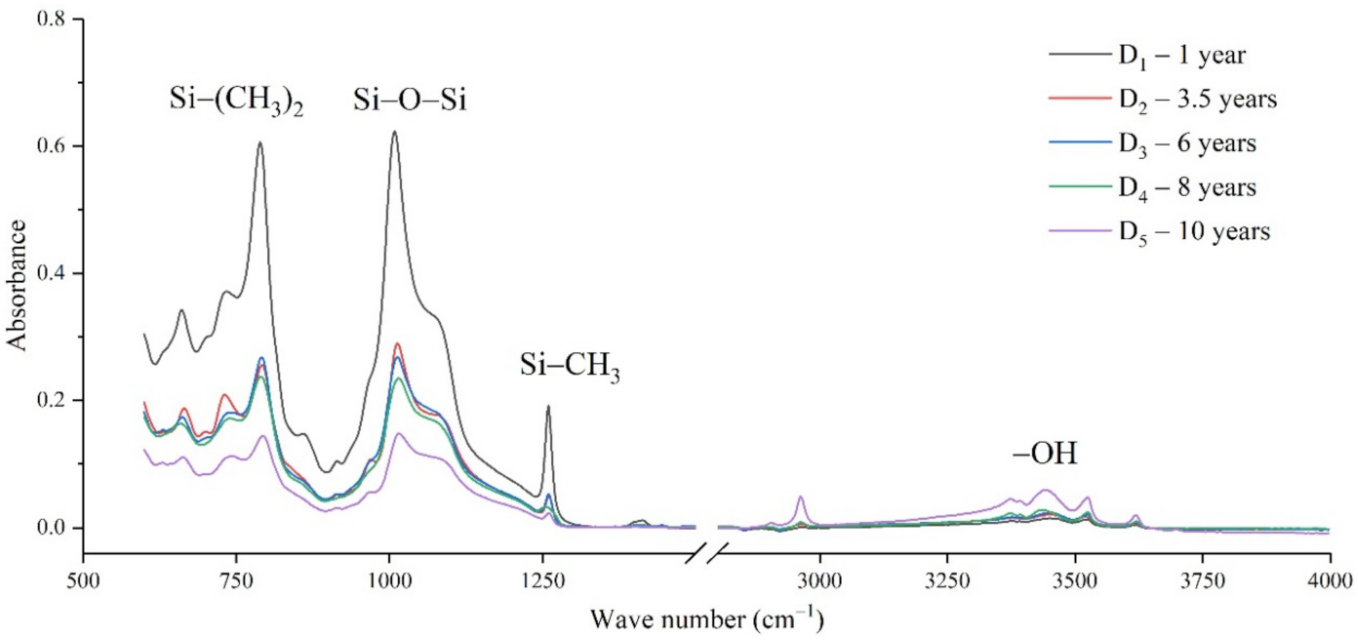
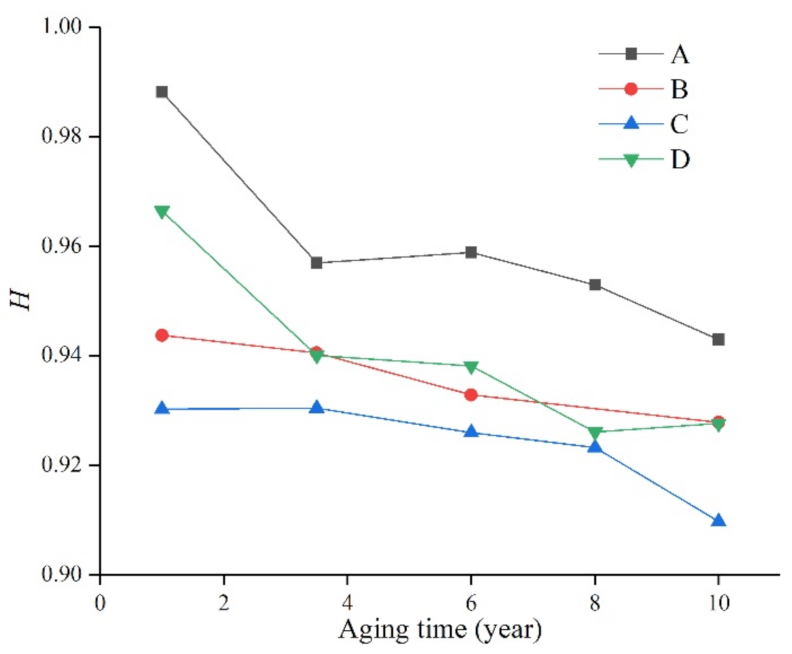

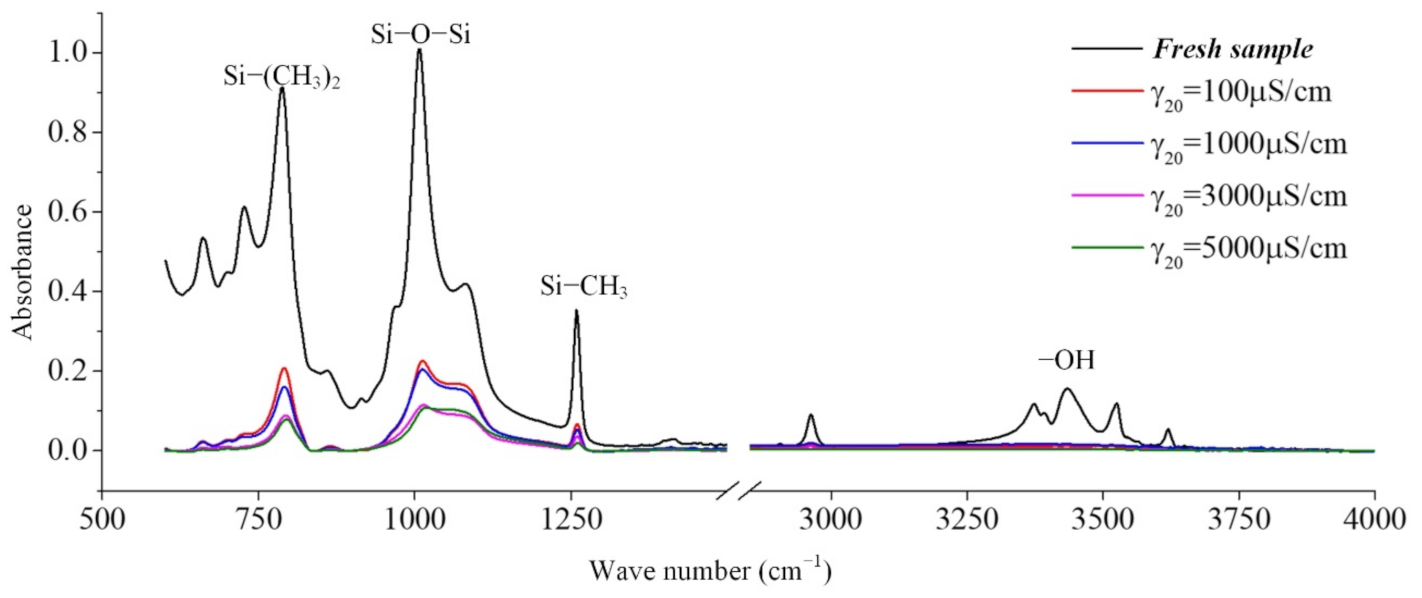
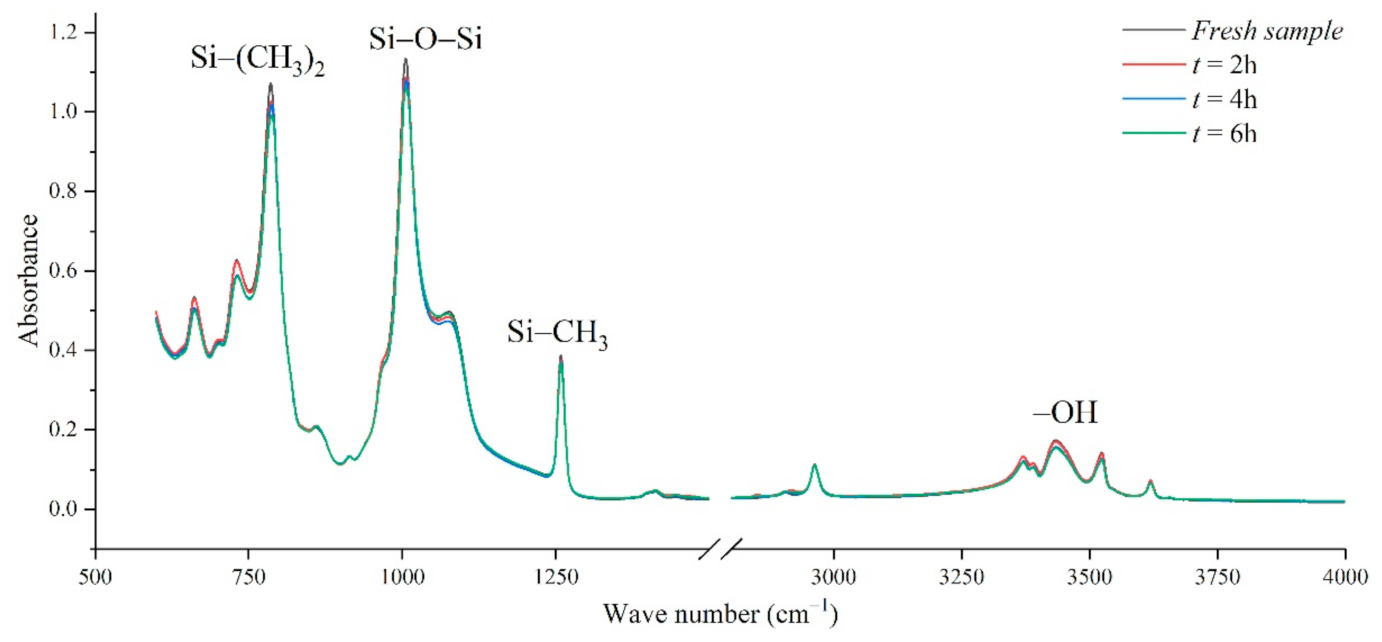
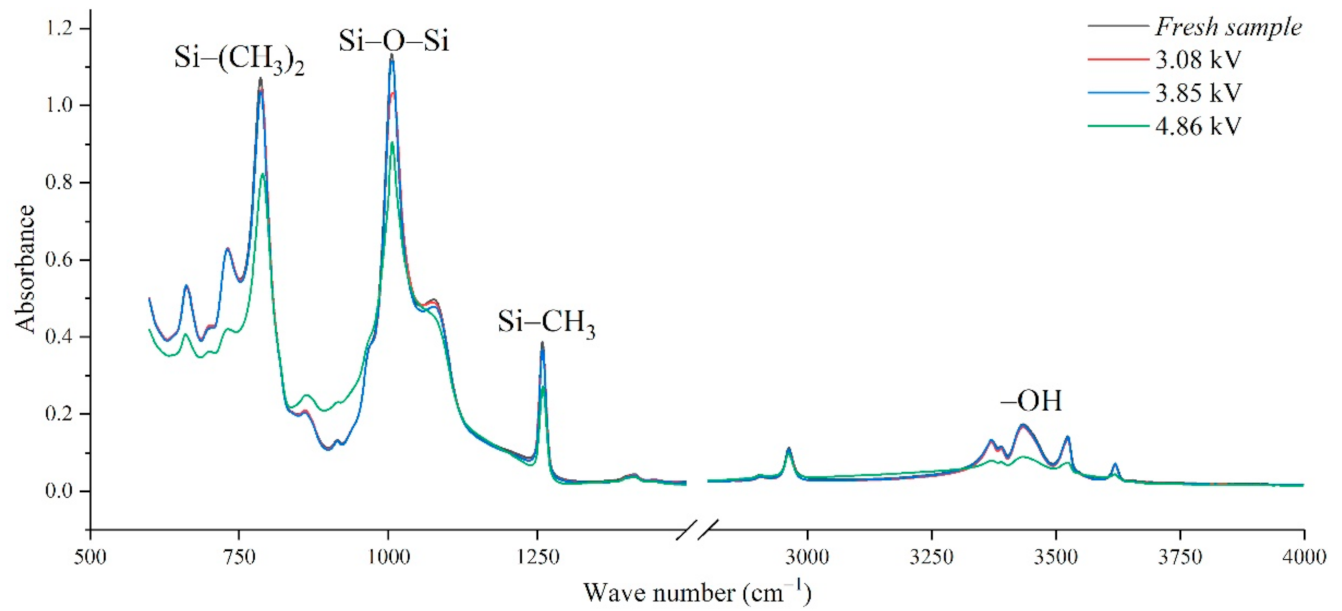

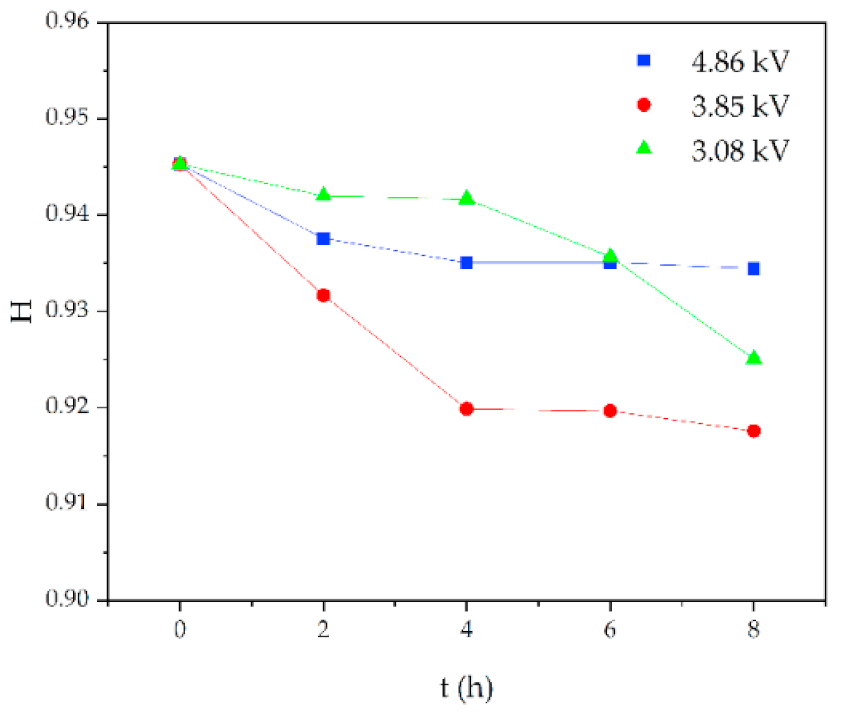
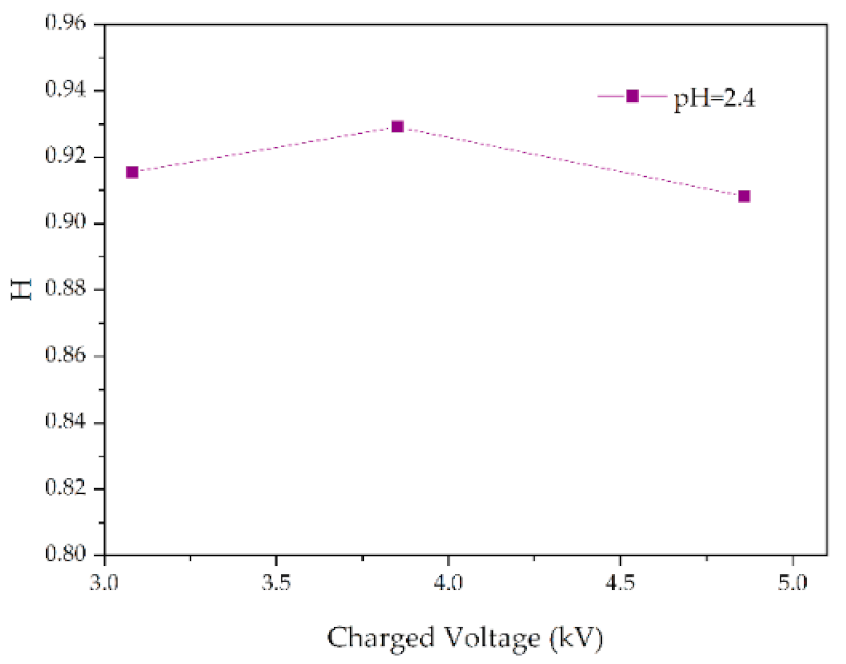

| Functional Group | Wave Number/cm−1 |
|---|---|
| Si(CH3)3 | 700–800 |
| O-Si(CH3)2-O | 790–840 |
| Si-O-Si | 1000–1100 |
| Si-CH3 | 1255–1270 |
| C-H in CH3 (bending) | 1410–1440 |
| CH in CH3 (stretching) | 2960–2963 |
| O-H in ATH, Si-OH | 3200–3700 |
| Aging Years | Samples | |||
|---|---|---|---|---|
| 1 | A1 | B1 | C1 | D1 |
| 3.5 | A2 | B2 | C2 | D2 |
| 6 | A3 | B3 | C3 | D3 |
| 8 | A4 | / | C4 | D4 |
| 10 | A5 | B4 | C5 | D5 |
| Samples | Si-(CH3)2 | Si-O-Si | H |
|---|---|---|---|
| A1 | 0.2448 | 0.2518 | 0.9881 |
| A2 | 0.2309 | 0.2413 | 0.9569 |
| A3 | 0.2189 | 0.2283 | 0.9588 |
| A4 | 0.1517 | 0.1592 | 0.9529 |
| A5 | 0.1354 | 0.1436 | 0.9429 |
| Samples | Si-(CH3)2 | Si-O-Si | H |
|---|---|---|---|
| B1 | 0.2228 | 0.2361 | 0.9437 |
| B2 | 0.2198 | 0.2337 | 0.9405 |
| B3 | 0.2139 | 0.2293 | 0.9328 |
| B4 | 0.203 | 0.2188 | 0.9278 |
| Samples | Si-(CH3)2 | Si-O-Si | H |
|---|---|---|---|
| C1 | 0.2363 | 0.2535 | 0.9302 |
| C2 | 0.2180 | 0.2343 | 0.9304 |
| C3 | 0.2049 | 0.2213 | 0.9259 |
| C4 | 0.1876 | 0.2032 | 0.9232 |
| C5 | 0.1451 | 0.1595 | 0.9097 |
| Samples | Si-(CH3)2 | Si-O-Si | H |
|---|---|---|---|
| D1 | 0.6027 | 0.6236 | 0.9664 |
| D2 | 0.2679 | 0.285 | 0.9400 |
| D3 | 0.2517 | 0.2683 | 0.9381 |
| D4 | 0.2177 | 0.2351 | 0.9260 |
| D5 | 0.1384 | 0.1492 | 0.9276 |
| T (h) | Si-(CH3)2 | Si-O-Si | H |
|---|---|---|---|
| Fresh sample | 0.914 | 1.000 | 0.914 |
| 2 | 0.820 | 0.956 | 0.858 |
| 4 | 0.416 | 0.461 | 0.902 |
| 6 | 0.219 | 0.264 | 0.830 |
| 8 | 0.161 | 0.205 | 0.785 |
| γ20 (μS/cm) | Si-(CH3)2 | Si-O-Si | H |
|---|---|---|---|
| Fresh sample | 0.914 | 1.000 | 0.914 |
| 100 | 0.208 | 0.227 | 0.916 |
| 1000 | 0.161 | 0.205 | 0.785 |
| 3000 | 0.090 | 0.115 | 0.783 |
| 5000 | 0.079 | 0.108 | 0.731 |
Publisher’s Note: MDPI stays neutral with regard to jurisdictional claims in published maps and institutional affiliations. |
© 2022 by the authors. Licensee MDPI, Basel, Switzerland. This article is an open access article distributed under the terms and conditions of the Creative Commons Attribution (CC BY) license (https://creativecommons.org/licenses/by/4.0/).
Share and Cite
Zhang, Z.; Liang, T.; Jiang, Z.; Jiang, X.; Hu, J.; Pang, G. Application of Infrared Spectroscopy in Research on Aging of Silicone Rubber in Harsh Environment. Polymers 2022, 14, 4728. https://doi.org/10.3390/polym14214728
Zhang Z, Liang T, Jiang Z, Jiang X, Hu J, Pang G. Application of Infrared Spectroscopy in Research on Aging of Silicone Rubber in Harsh Environment. Polymers. 2022; 14(21):4728. https://doi.org/10.3390/polym14214728
Chicago/Turabian StyleZhang, Zhijin, Tian Liang, Zhenglong Jiang, Xingliang Jiang, Jianlin Hu, and Guohui Pang. 2022. "Application of Infrared Spectroscopy in Research on Aging of Silicone Rubber in Harsh Environment" Polymers 14, no. 21: 4728. https://doi.org/10.3390/polym14214728
APA StyleZhang, Z., Liang, T., Jiang, Z., Jiang, X., Hu, J., & Pang, G. (2022). Application of Infrared Spectroscopy in Research on Aging of Silicone Rubber in Harsh Environment. Polymers, 14(21), 4728. https://doi.org/10.3390/polym14214728








